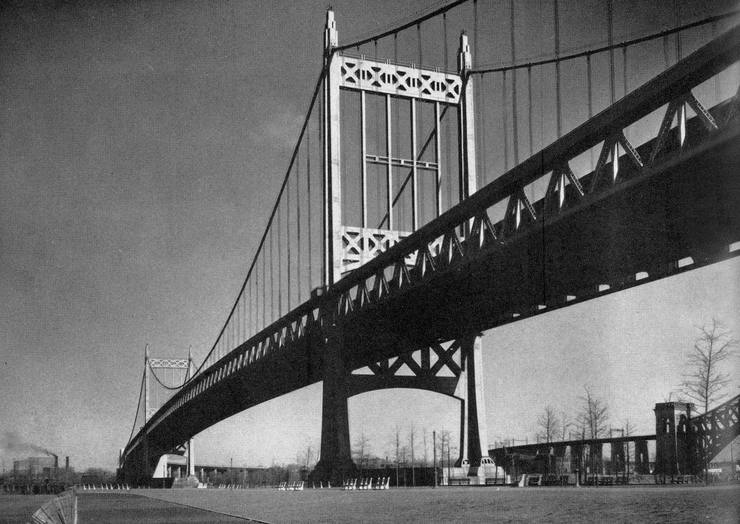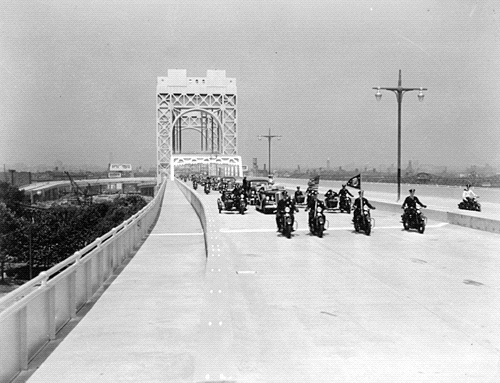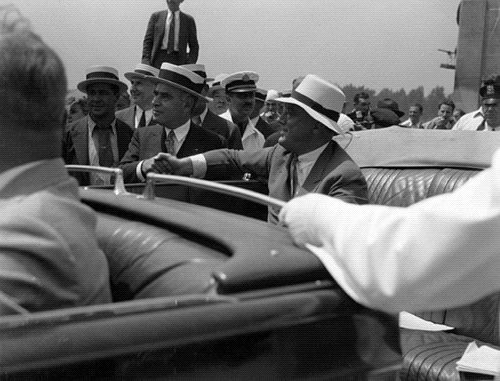

| 
| |
|
President Franklin D. Roosevelt at the opening of the Triborough Bridge, July 11, 1936.
These two photos: New Deal Network. Click each photo to enlarge. Left: Presidential motorcade over the East River Lift Bridge. Right: President Roosevelt and New York Governor Lehman. President Roosevelt's Address: CLICK HERE. Video: CLICK HERE | ||
Funds gave out. The project languished and was not revived until the Federal government launched the first depression public works program through the Reconstruction Finance Corporation in 1932 ... Early in 1933 Governor Lehman had appointed the State Emergency Public Works Commission, of which I became chairman. The purpose of this commission was to present sound, self-liquidating projects within the state for financing by the RFC. The Triborough Bridge headed this list ... we journeyed to Washington for our first lively contact with Harold L. Ickes as Public Works Administrator. In accordance with an agreement with the Public Works Administration, the [Triborough Bridge] Authority sold that agency $35 million in bonds under an arrangement by which the Federal Government provided a grant in aid of construction totaling 30 percent of the direct construction cost of the bridge. This government grant amounted to $9.2 million.Robert Caro[3] says that Moses...
...persuaded Mayor O'Brien to ask the Legislature to establish a Triborough Bridge Authority that could issue its own bonds, secured by toll revenues, and that would therefore be eligible for aid from the newly formed Public Works Administration, and the PWA granted a $44,200,000 combination loan and grant to the Authority on condition that the city make certain token contributions.This is only the beginning of a long story, but in the end the bridge was built with a combination of federal loans and grants on top of a small amount of initial city funding. The Triborough Bridge was one of the largest public works projects of the Great Depression, even more expensive (according to Wikipedia) than the Hoover Dam.
The WPA Guide to New York City[4] adds:
To prevent the customary degeneration of underbridge land into unsightly catchalls, these parts of the Triborough right of way were landscaped as parks and playgrounds. At the Astoria [Queens] end a large riverside park includes a mammoth outdoor swimming pool as well as shady walks and play spaces. On Randall's Island two old institutions, The Children's Hospital and the House of Refuge, were razed and the whole island was transformed into a recreational park around a great municipal stadium. These were made accessible from the bridge. Under the Manhattan ramps at 124th Street another large recreation field was built ... Of the total cost of $60,300,000, New York City appropriated $16,1000,000, while the Federal Public Works Administration made a grant of $9,200,000 and bought $35,000,000 of bonds. In 1937 these bonds were bought back from the the Government and were refinanced by direct sale to the public ... To the pedestrian, the bridge offers one of the most spectacular high-level walks in the country. In recommending that walkers start from the Astoria end, Lewis Mumford wrote: “Here is one of the few places where one can see New York across a foreground of verdure and water and it must be counted one of the most dazzling urban views in the world.”
The top photo was probably taken on Wards's Island, where the Triborough and Hell Gate bridges approach each other, curving around to the northeast (see next photo). It is no accident that the bridge opened just in time for the 1939 World's Fair in Flushing Meadow, Queens, to which it provided easy access from both the Bronx and Manhattan.
Click here to see a WPA painting of the bridge in the main Manhattan Post Office.
References
- Short, C.W., and R. Stanley Brown, Public Buildings, A Survey of Architecture of Projects Constructed by Federal and Other Governmental Bodies between the Years 1933 and 1939 with the Assistance of the Public Works Administration, United States Govenment Printing Office, Washington (1939), page 545.
- Moses, Robert, Public Works, McGraw Hill (1970), p.685.
- Caro, Robert A., The Power Broker, Vintage Books (1974), p.345.
- The WPA Guide to New York City (1939), in reprint by The New Press (1990), p.391.
- Ickes, Harold, "PWA, a Four-Year Record of the Construction of Permanent and Useful Public Works, 1934, 1935, 1936, 1937. Federal Emergency Administration of Public Works (1937).
- $109,993,500 Set Aside For PWA Work in City, New York Times, 13 June 1934, p.4: "The Triborough Bridge Authority will receive $42,200,000."
- Moses Gets Funds for City Stadium, New York Times, Thursday, September 12, 1935, p.27. ”.. the bridge is being financed with a $43,000,00 PWA loan and grant.”
|
The New Deal in
NYC 1932-1943 |
Frank da Cruz |
fdc@columbia.edu
|